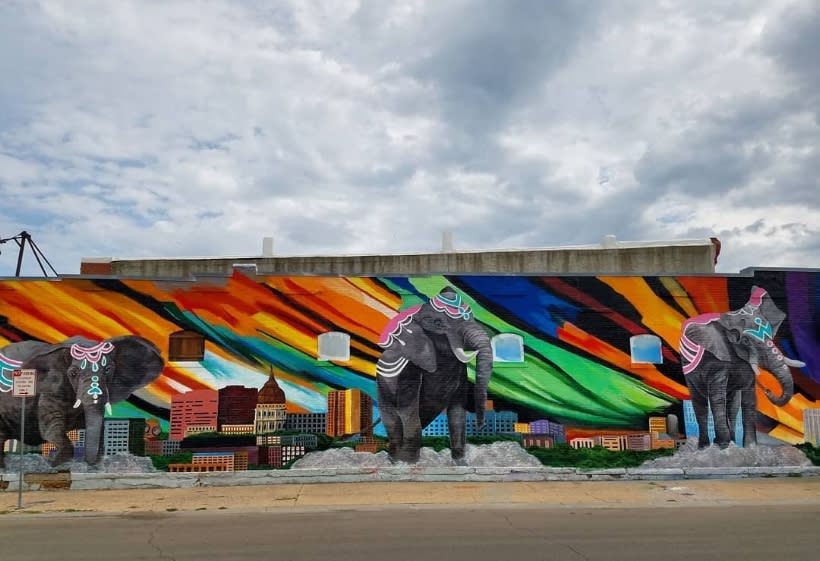


In the end, the first artist to call NOTO its home was a Topeka native.īarbara Waterman-Peters was excited in 2009 about the potential for community revitalization and decided to attend a Heartland Visioning community meeting for artists. Wolgast said they were focused on bringing in artists from outside of Topeka. In order to do that, Wolgast and Hunter’s team decided to offer incentives. Now that a location was chosen and money had been raised, it was time to fill the space with businesses and artists. Support poured in from states as far away as New York, and local businesses, organizations and families donated, as well. “Our fundraising goal was $500,000 and it turns out we ended up raising well over $1 million,” Wolgast said. Kansas Avenue was voted on as the new home of NOTO, fundraising was the next big step. It was already built for what we thought we wanted to do.” “I remember the morning we drove over the bridge and we walked the streets and looked at the facade of those buildings,” Wolgast said. Still, Wolgast and Hunter wanted to consider the once-thriving business district as an option. One was Bradley’s Cafe and the other across the street was Robuck Jewelers.“Īt the time, North Topeka wasn’t a safe place as violent crimes plagued the area. “From this wonderful business community that couldn’t survive, it had deteriorated drastically and there were a few businesses that were still in business. “Some people mentioned North Topeka and at that point, it was called NOTO in a derogatory way,” Wolgast said. “So we were feeling confident that we would get the support of the community.”Īfter receiving community support from stakeholders, the next challenge was to find a location for the arts district. “That first year we were still feeling our way around and we felt the excitement of Heartland Visioning and support as we went around and talked to people,” Wolgast said. Wolgast and Hunter spent the first year of the development process in 2009 talking to the community, conducting research and developing a plan. Wolgast and Hunter, who were both in leadership positions on Heartland Visioning’s arts and culture team, were approached and asked to spearhead the development of the arts district.Īccording to Wolgast, the team of volunteers had no budget and it was up to them to raise money for the arts district project.

Through a community-wide survey, one common idea came to the surface: Topeka wanted an arts district.

Topeka’s Chamber of Commerce in 2008 began to develop a visioning process through Heartland Visioning. In fact, Wolgast and Hunter are largely responsible for the development of the NOTO Arts and Entertainment District. Underwood shares the opinion that the rerouting of the bridge caused the North Topeka business district to decline, along with the overall expansion of businesses and residential areas to the outskirts of the city.Īnita Wolgast and John Hunter aren’t strangers to what it takes to build an arts district from the ground up. Still, businesses and the Topeka Rescue Mission remained in the district. The new bridge is what many considered to be the downfall of the district and what led to the area being unsafe to visit. The collapse killed one person, according to Topeka Capital-Journal archives.Ĭonstruction began on a replacement bridge in 1964 that would reroute traffic to the east of N. Then North Topeka experienced its second blow when the Melan Bridge, which was the connection between south and North Topeka, collapsed on July 2, 1965. To this day, flood mud still remains in the basements of some of NOTO’s buildings. Several businesses located in the North Topeka business district weren’t able to recover from the devastating flood waters. In Topeka alone, over 7,000 buildings were damaged or destroyed by flooding. Starting on July 9 and ending July 13, the Kansas River received on average eight inches of rain, with some areas experiencing up to 18.5 inches, according to the Kansas State Historical Society. It was in 1951 that North Topeka suffered one of its first big hardships. It was just a general area that served the neighborhood.” “That was our general go-to place for shopping,” Underwood said.
NOTO TOPEKA MOVIE
Underwood recalls spending quite a bit of time during his childhood roaming the streets of the business district, eating hamburgers with his friends, going to the movie theater and getting his hair cut.


 0 kommentar(er)
0 kommentar(er)
